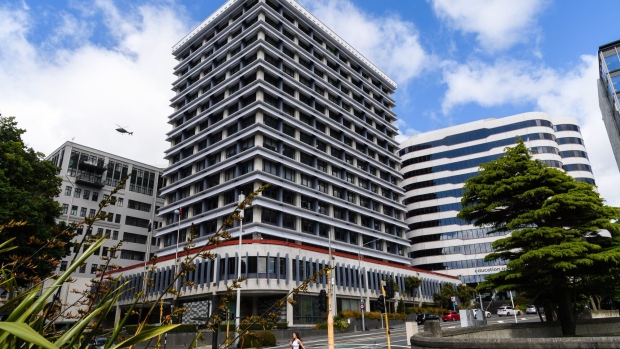Apr 4, 2023
New Zealand Unexpectedly Lifts Key Rate by Half Percentage Point
, Bloomberg News

(Bloomberg) -- New Zealand’s central bank unexpectedly raised interest rates by 50 basis points, maintaining its pace of tightening to tame inflation even as the economy heads toward recession. The currency jumped.
The Reserve Bank’s Monetary Policy Committee increased the Official Cash Rate to 5.25% from 4.75% Wednesday in Wellington, wrong-footing most economists who expected a 25-point hike.
“The Committee agreed that the OCR needs to be at a level that will reduce inflation and inflation expectations to within the target range over the medium term,” the RBNZ said in a statement. “Inflation is still too high and persistent, and employment is beyond its maximum sustainable level.”
The RBNZ’s decision to keep raising rates at pace underlines its determination to get inflation back to its 1-3% target. There are signs the economic slowdown policymakers are seeking to engineer is underway. House prices posted a record fall in the year through March and business confidence is near its lowest since the early 1970s.
“We see a growing risk that demand is cooling relative to the economy’s supply capacity quicker than the RBNZ is currently estimating,” said Nick Tuffley, chief economist at ASB Bank in Auckland. “If we see further signs of weak demand and easing capacity pressures, then the RBNZ may judge it has already done enough.”
Still, ASB today revised its projections and now sees a peak for the OCR in May of 5.5% rather than 5.25%.
The New Zealand dollar jumped as much as 1.1% after the decision. It bought 63.52 cents at 3:05 p.m. in Wellington, from 63.08 cents beforehand. Swap rates and bond yields rose.
The RBNZ, which raised the OCR by 50 points in February and a jumbo 75 points in November, is pressing ahead with rapid rate increases just as other central banks reduce the pace of tightening or pause.
The US Federal Reserve has slowed its tightening to quarter-point steps, while the Bank of Canada and Bank of Korea have stopped raising rates after inflation in both countries eased. Australia’s central bank yesterday held its cash rate unchanged at 3.6%, though it warned that some further tightening may still be needed.
The RBNZ said policymakers discussed recent banking stress in the US and Europe, and concluded that domestic lenders are well placed to face any risks. It said there was no material conflict between lowering inflation and maintaining financial stability.
Today’s decision was an interim review rather than a quarterly Monetary Policy Statement, so the bank didn’t issue new forecasts and there is no press conference with Governor Adrian Orr. In its most recent projections in February, the RBNZ forecast the benchmark rate rising to 5.5% in the second half of this year.
“In aggregate, economic projections were little changed relative to the February statement,” the RBNZ said in its record of meeting today. It said the demand on resources needed for rebuilding after recent North Island flooding and cyclone damage is expected to add to inflation pressure more than previously assumed.
Wholesale Rates
The committee discussed 25 and 50 basis-point increases, it said.
While policymakers are comfortable that current lending rates faced by businesses and households will help ensure inflation begins to moderate, wholesale interest rates have fallen significantly since the February decision, the RBNZ said.
“This could put downward pressure on lending rates,” it said. “As a result, a 50 basis-point increase in the OCR was seen as helping to maintain the current lending rates faced by businesses and households, while also supporting an increase in retail deposit rates.”
Before today’s decision, most economists considered the OCR to be near its peak, with the majority expecting a 25-point move today and one more at the next review on May 24 to 5.25%.
While the central bank has projected a recession starting in the second quarter, there is a risk the slowdown may have come earlier after the economy unexpectedly contracted in the three months through December.
“The level of economic activity over the December quarter was lower than anticipated in our February Monetary Policy Statement and there are emerging signs of capacity pressures in the economy easing,” the RBNZ said. “However, demand continues to significantly outpace the economy’s supply capacity, thereby maintaining pressure on annual inflation.”
Inflation was 7.2% in the fourth quarter and the RBNZ in February predicted it would slow to 5.3% by the end of 2023.
“Looking ahead, the Committee is expecting to see a continued slowing in domestic demand and a moderation in core inflation and inflation expectations,” the RBNZ said. “The extent of this moderation will determine the direction of future monetary policy.”
(Updates with economist’s comment in fifth paragraph)
©2023 Bloomberg L.P.





